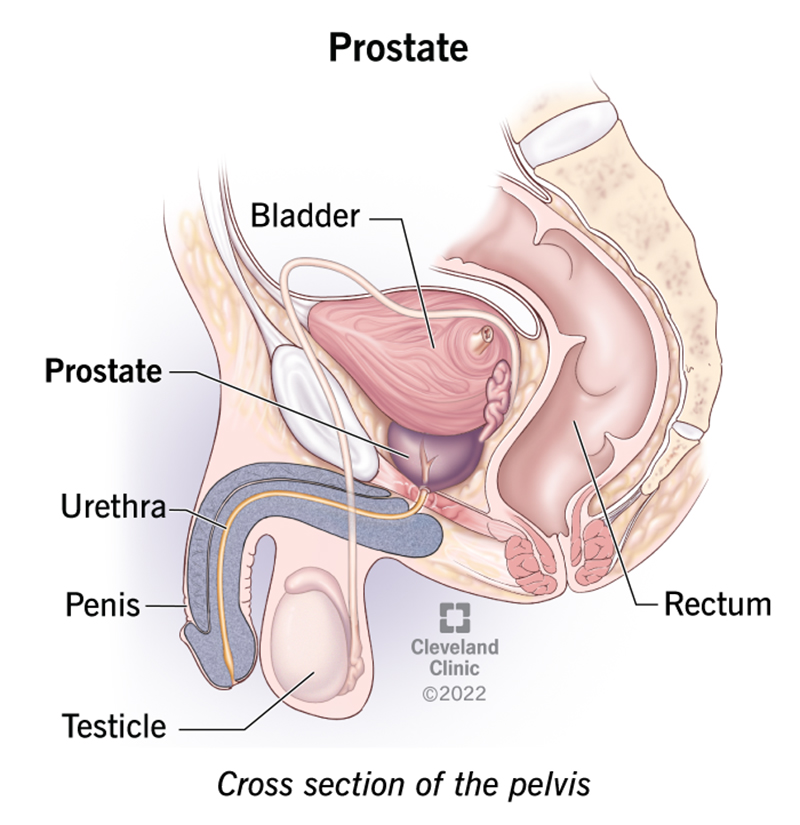The prostate is a gland below the bladder and in front of the rectum in men and people assigned male at birth (AMAB). It consists of connective tissues and glandular tissues. It adds fluid to semen, and its muscles help push semen through your urethra. Conditions that affect your prostate include cancer, prostatitis and benign prostatic hyperplasia.

The prostate is a small gland that’s part of the male reproductive system.
Cleveland Clinic is a non-profit academic medical center. Advertising on our site helps support our mission. We do not endorse non-Cleveland Clinic products or services. Policy
Your prostate contributes additional fluid to your semen (ejaculate). Ejaculate is a whitish-gray fluid that releases from your penis when you orgasm. The fluid contains enzymes, zinc and citric acid, which help nourish sperm cells and lubricate your urethra (pronounced “yer-ree-thruh”). The urethra is a tube through which ejaculate and pee flow out of your body.
Your prostate’s muscles also help push semen into and through your urethra when you orgasm.
No, women don’t have a prostate. Women and people assigned female at birth (AFAB) have Skene’s glands. However, some people refer to Skene’s glands as the female prostate gland.
The Skene’s glands are on either side of the urethra. Medical researchers believe these glands may secrete fluid that helps with urination (peeing) and cleanliness. They may also have a function for sexual intercourse, possibly providing the fluid for female ejaculation.
Your prostate is below your bladder and in front of your rectum. Your urethra runs through the center of your prostate.
Your prostate has five lobes: anterior (in the front) and posterior (in the back) lobes, two lateral lobes (on the sides) and one median (in the middle) lobe. Connective tissues and glandular tissues make up its structure. The prostatic fascia covers your prostate. Prostatic fascia is a sheet of stretchy connective tissue.
Your prostate is about the size of a walnut.
The prostate usually gets larger after age 40 (benign prostatic hyperplasia). It can grow from the size of a walnut to the size of a lemon. Benign prostatic hyperplasia (BPH) isn’t cancerous, and it doesn’t increase your risk of developing prostate cancer.
Your prostate weighs about 1 ounce (30 grams), which is as heavy as five U.S. quarters.
Common conditions that affect your prostate include:
Common warning signs of prostate problems include:
Common tests to check your prostate health include:
Prostate treatment depends on the type of condition you have.
Depending on the cause and type of your prostatitis, your healthcare provider may recommend:
Help keep your prostate healthy by:
Dietary supplements don’t have to go through clinical trials or get approval from the United States Food and Drug Administration (FDA), so there isn’t much data on them. Supplements may show minor benefits, but most people won’t see an improvement in their prostate health from taking them.
Yes, you can live without your prostate.
If you have prostate cancer, you and your healthcare provider may decide to remove your entire prostate gland. Common side effects of living without a prostate include ED and uncontrollable peeing.
You can’t touch your prostate, but you can feel it from the outside of your body (externally) or through your rectum (internally).
The easiest way to feel your prostate is from the back half of your perineum, near your rectum. The area mainly contains nerves and veins, not tissue. Your prostate should feel soft or rubbery.
You can also feel your prostate more directly through your rectum. Your prostate is about two inches inside your rectum. It’s between your penis and your rectum, and it feels soft or rubbery.
When you touch your prostate externally or internally, you may feel a sudden urge to pee.
Many people find prostate stimulation sexually satisfying. However, you can’t accurately check your prostate health through a self-examination. If you have any concerns about your prostate health, talk to a healthcare professional. They can answer any of your questions and accurately assess your prostate health.
A note from Cleveland Clinic
Your prostate is a small, walnut-shaped organ. It’s below your bladder and in front of your rectum. Its primary functions are to create fluids in your semen and force semen through your urethra when you ejaculate. Your prostate will likely get larger as you age, which is normal. Prostate cancer is the second most common cancer that affects men and people AMAB. It’s a good idea to get regular prostate screenings after you turn 50. If you notice any symptoms that indicate prostate conditions, talk to your healthcare provider.
Last reviewed by a Cleveland Clinic medical professional on 08/09/2022.
Learn more about our editorial process.
Cleveland Clinic is a non-profit academic medical center. Advertising on our site helps support our mission. We do not endorse non-Cleveland Clinic products or services. Policy